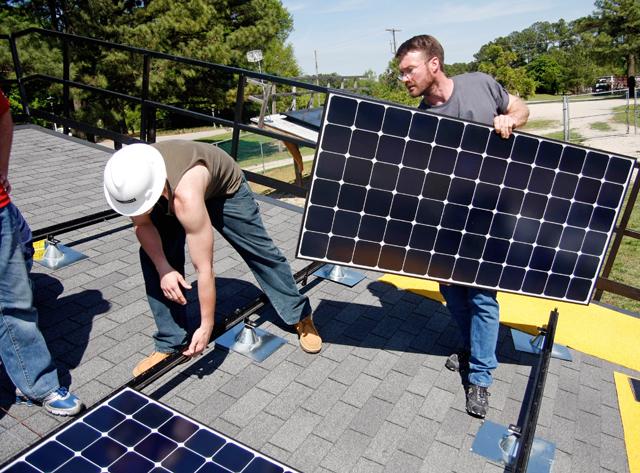
©
Working at the University Solar Center, Pennsylvanian engineers Matt Wilson, from Secco Inc., and Jeff Sloat, from Summit Electric, instal solar panels as part of a national training course put on by SunPower Corporation Thursday. Wilson had worked in the solar installation industry and installed about 100 systems. Sloat is training to be the lead technician at his company. Photo by Tim O'Brien.
The daily grind of schoolwork, research and socializing may distract students from the issue of whether our campus is sustainable and environmentally friendly, but N.C. State has made efforts in redefining its “green” image. These changes, though perhaps not visible to the student body, go beyond the number of recycling bins on campus.
“I don’t really know of their ‘going green’ efforts, but I notice all the recycling bins everywhere,” Darius Hargrove, a freshman in First Year College, said. “But other efforts are unknown to me.”
Although North Carolina policies have made recycling bins more accessible to the community, recycling alone is not enough in efforts to be more sustainable, according to Tracy Dixon the director of the Office of Sustainability.
“There are tons of recycling bins everywhere,” Kevin Blake, freshman in First Year College, said. “You can tell that it’s important to the people running campus.”
Many students do not even know that there is an Office of Sustainability at N.C. State.
“It is important to spread awareness about sustainability so that students have a better understanding that the actions we take today have an impact on life in the future,” Dixon said. According to her, increasing availability to recycling is a step in the “green” direction, but as students, there are additional steps the campus can take to help our environment and community—and support isn’t too far away.
In 2008, N.C. State did an initial assessment and discovered it emits 270,000 tons of greenhouse gases per year. As a result, the chancellor signed a Climate Commitment for the University in a pledge to lower emissions.
A team dedicated to sustainability devised a plan, which focused on the eight groups that contribute to the waste of energy and gas emissions on campus: academics and research, energy and water, land use, materials and purchasing, transportation, community and culture, waste reduction and recycling and buildings.
They found that buildings were the cause of 87 percent of carbon emissions on campus. Following this discovery, N.C. State has made sure that all new buildings are under Leadership and Energy Environmental Design. This means that the building is designed to be energy efficient and to emit as little greenhouse gases as possible.
The only problem is with existing buildings on campus that are not up-to-date with those measures. Ten experts from engineering, solar energy science and similar areas have designed the 13 Building Performance Contract to cope with the situation. This project will upgrade the buildings using the most energy to make them more efficient with regards to cost and emissions. These buildings include: Caldwell Hall, Carmichael Gym, the College of Textiles building, Cox Hall, Dabney Hall, the McKimmon Center, Monteith Research Center, MRC Parking Facility, the Research 1 building, the Structures Lab, Tompkins Hall and Winston Hall. This project is estimated to cost $19 million and the savings from building efficiency will be 1.4 million dollars a year.
According to the plan’s outline, the things that will be improved upon will be lighting, controls, HVAC, renovations, insulation, windows, solar thermal, low flow fixtures and building metering. This job is expected to be done within 20 years. According to Dixon, the 13 building performance contract will reduce carbon emissions of N.C. State by 13,000 tons yearly. This is equal to planting over 1,000,000 trees yearly.
This project is only a part of what the sustainability team is working towards. However, improvement in energy policy and efficiency relies heavily on actions taken by students. All campus activities, from flushing a toilet to turning off a light switch, make a difference, according to Dixon.
Dixon says that there are other ways, besides turning off the lights or water, in which students can make a difference. There are a number of sustainability groups including the Campus Environmental Sustainability Team and Wolfpack Environmental Student Association, and sustainability competitions like “Think Outside The Brick” or the Reusable Regatta that provide outlets for environmental thinking.
According to Dixon, by this summer there will be “virtual rooms” on the Office of Sustainability website to show students how much energy each appliance within their rooms, offices and suites use. Other opportunities to become active include campaigns such as Change Your State, a mission to make N.C. State students, employees and staff more environmentally conscious. The goal this first year is to reduce the amount of electricity we use on campus by 5%. This can be accomplished through individual behavior change and simply switching lights off when they are not needed.
However, these changes are not unique to the University. The state of North Carolina has taken large efforts to become more environmentally friendly. In 2007, Forbes magazine reported that North Carolina was the 3 most environmentally friendly state in which to do business.